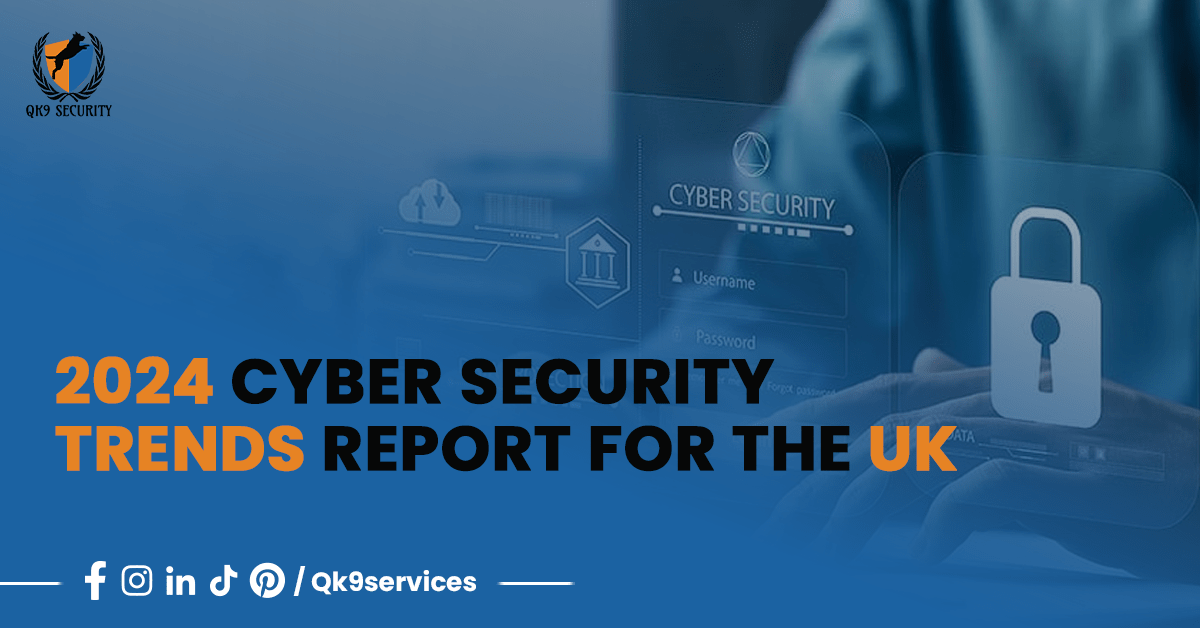2024 Cybersecurity Trends Report for the UK

Navigating the Evolving Cybersecurity Landscape in the UK:
In the rapidly evolving digital landscape, the cybersecurity environment in the UK is undergoing continuous transformation. While new technologies offer exciting opportunities, they also introduce novel vulnerabilities and threats. To effectively navigate this dynamic landscape, it is imperative to understand and adapt to emerging trends. This report explores the major developments in cybersecurity that will influence the UK in 2024, providing organizations and individuals with insights to enhance their cybersecurity defenses.
1. AI & ML Take Center Stage in Defense
Artificial intelligence (AI) and machine learning (ML) have transitioned from futuristic aspirations to pivotal tools in cybersecurity. AI and ML-powered solutions can analyze vast datasets in real-time, enabling the identification of anomalous behavior and the prediction of potential threats with unprecedented accuracy. This shift towards proactive threat detection marks a significant advancement in cybersecurity defense strategies.
2. The Rise of Ransomware-as-a-Service (RaaS)
Ransomware-as-a-Service (RaaS) presents a growing threat as cybercrime becomes increasingly commercialized. Criminal entities with limited technical expertise can rent the tools and infrastructure necessary to execute sophisticated ransomware attacks. This commodification of cybercrime makes such attacks more widespread and unpredictable, emphasizing the importance of robust data backup solutions and comprehensive employee cybersecurity training.

3. Social Engineering
Despite technological advancements, social engineering remains a persistent threat. Tactics such as phishing and pretexting continue to exploit human vulnerabilities, tricking individuals into compromising sensitive information or granting unauthorized access. Ongoing employee education and the implementation of strong security policies are crucial in mitigating this risk.
4. Cloud Security in Focus
The widespread adoption of cloud technologies necessitates a shift in security paradigms. Traditional perimeter-based security models struggle to adequately secure the distributed nature of cloud environments. Organizations must embrace cloud-native security solutions and establish a shared responsibility model with cloud providers to ensure comprehensive cloud security.
5. Supply Chain Attacks
The interconnected nature of modern supply chains creates a vast attack surface for cyber threats. Hackers exploit vulnerabilities in one vendor to gain access to other organizations further down the chain. Establishing trust and implementing robust security measures throughout the supply chain is essential to mitigate this risk.
6. The Expanding Attack Surface
The proliferation of Internet of Things (IoT) devices expands the cyber attack surface. These devices often lack robust security measures, making them easy targets for cybercriminals. Organizations must implement secure device management practices and prioritize identifying and mitigating vulnerabilities in connected devices.
7. Geopolitical Landscape and Cyberwarfare
The rise of cyber warfare introduces additional complexity to the cybersecurity landscape. Nation-states increasingly employ cyberattacks to achieve political and economic objectives. Organizations must remain vigilant regarding evolving geopolitical threats and fortify their defenses accordingly.
8. Workforce Shortages and the Talent Gap
The cybersecurity industry faces a significant talent shortage, hindering organizations’ ability to manage cyber risks effectively. Initiatives to attract and retain cybersecurity talent, including increased training programs and competitive compensation packages, are crucial to bridge this gap.
The Importance of Cyber Resilience
Cybersecurity is a critical component of cyber resilience, encompassing various sub-components such as endpoint security, network security, and security awareness training. Today’s global trends, including the evolving threat landscape, ubiquitous connectivity, market complexities, and regulatory requirements, underscore the importance of cyber resilience in safeguarding businesses against cyber threats.
Regulatory Landscape and Compliance
The regulatory landscape surrounding cybersecurity is constantly evolving, with emerging regulations such as the NIS2 Directive in the EU. Organizations must stay abreast of regulatory developments and ensure compliance to mitigate the risk of penalties and reputational damage.
Conclusion
The cybersecurity landscape in the UK is dynamic and continuously evolving. By understanding and adapting to the trends outlined in this report, organizations and individuals can navigate the evolving threat landscape and bolster their defenses against cyberattacks. Investing in advanced technologies, prioritizing employee education, and fostering a culture of cyber resilience is imperative in safeguarding against the ever-changing cybersecurity landscape.
ALSO READ


One thought on “2024 Cybersecurity Trends Report for the UK”
This post is so interesting. I can’t wait to read more from you.